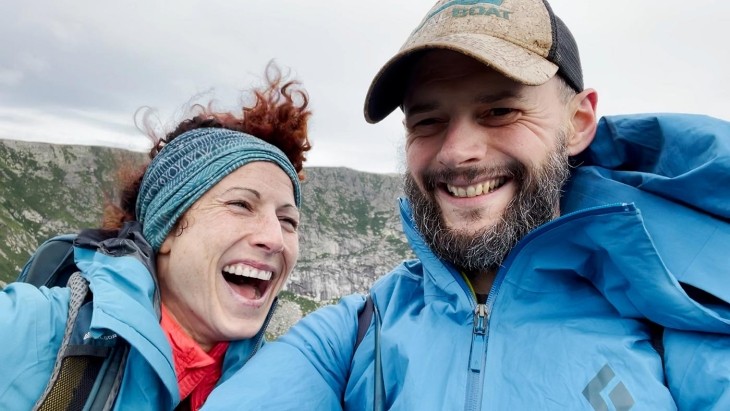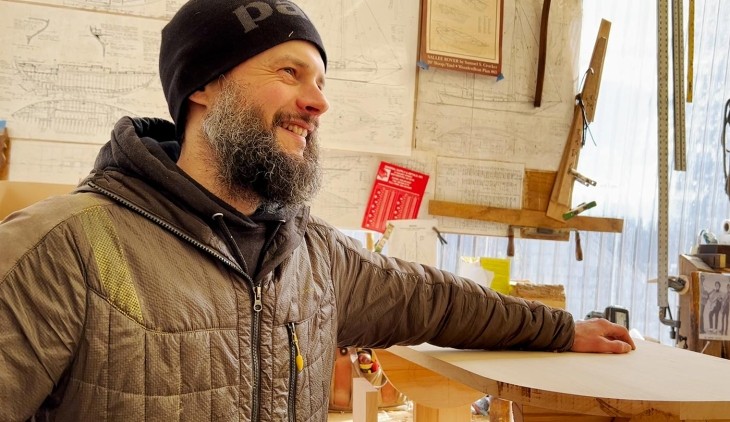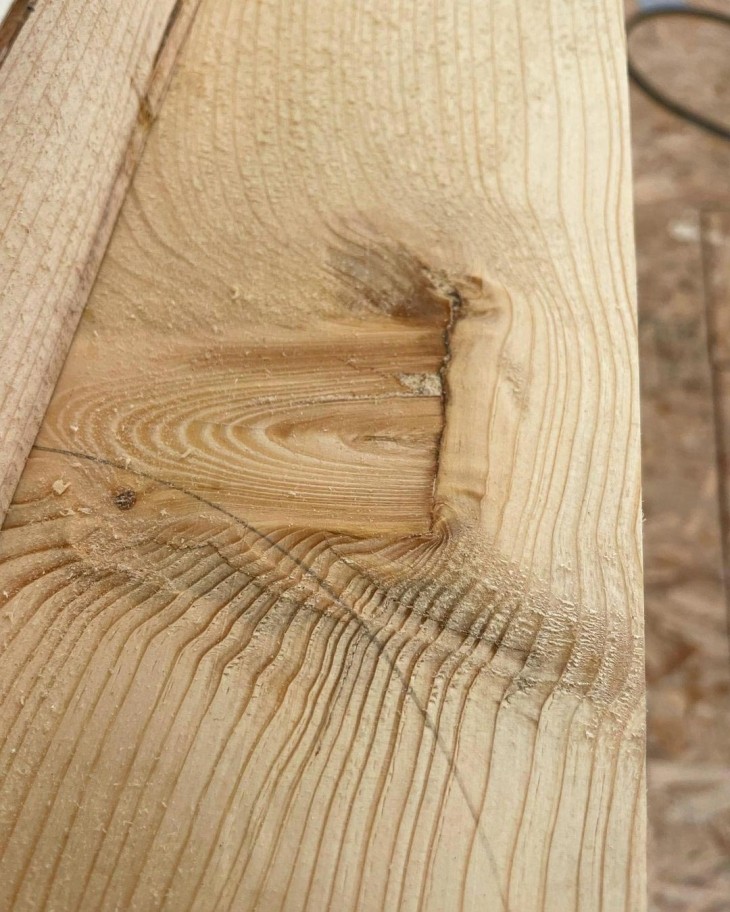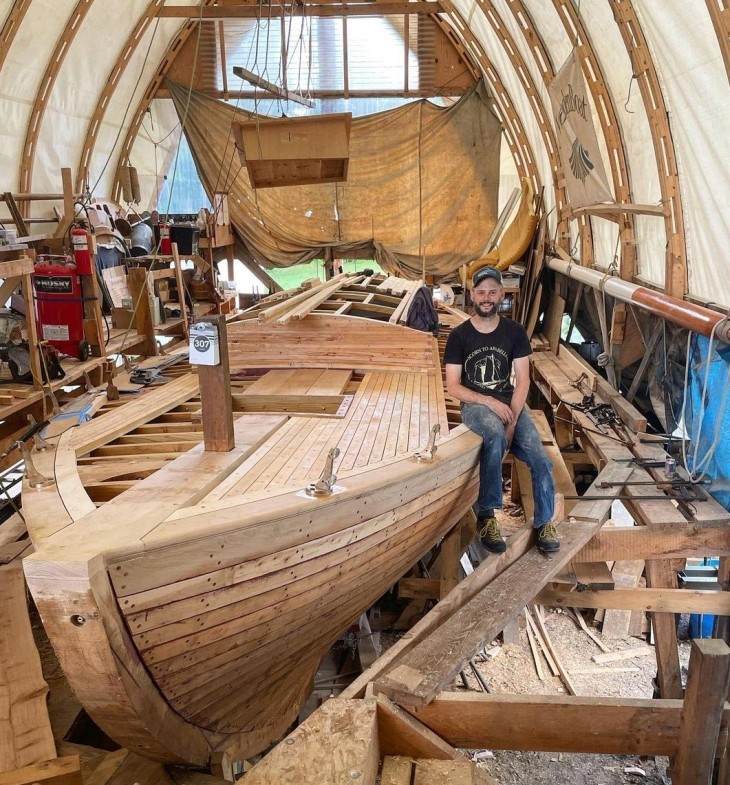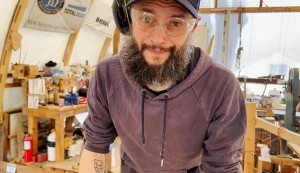
Steve Denette has rock climbed in Yosemite, sea kayaked along the coast of Maine and canoed the state’s inland lakes and rivers, and completed countless traverses in the White Mountains and beyond. For the past seven years, he’s been building a 38-foot sailboat, largely from trees he’s harvested on the small farm in Granby, Massachusetts, where his family has lived for five generations. He’s documented that effort, dubbed Acorn to Arabella, through a series of YouTube videos. He plans to launch Arabella into the Atlantic on June 17 from Mattapoisett, more than 100 miles from where she was built. It will be his first time sailing.
I couldn’t tell you when I started building things. It’s just something that’s been there my whole life, before I have any memory of it. When I was a little kid, when I walked out my backdoor, my grandparents lived on the right, and my great-grandparents lived on the left. And they were always doing something. My grandfather, when he was in his 20s, he cut down the trees and milled the lumber and built his house. And when I was around 6 or 8 years old, they cut down a bunch of trees, the sawmill came in, they milled lumber, built a barn. I just grew up around people who built things, fixed things, modified things. As a kid, we just kind of flowed around. We’d go help Great-grandpa with the grape arbor, then go clear hayfields with Grandpa.
I went to Unity College in Maine, where I studied adventure education and leadership. I did lots of backpacking, paddling, rock climbing, ice climbing, mountaineering. From there I went to Yosemite and guided for a little while, and I worked for the Appalachian Mountain Club leading trips for a number of years. Then I went back to school and earned a master’s in education from Springfield College in Massachusetts. I graduated from that into the heat of the 2008 recession and worked as a roofer for a little while, because that was the best paying job I could get with a master’s degree. I ended up becoming the head route setter for a big climbing gym in Hadley, Mass. I did that for six years, and then I left to build the boat.
There is pretty much no place that I’ve been in the natural environment that that hasn’t knocked my socks off. The desert and highlands of New Mexico, the deep valleys of West Virginia, the pine barrens of Maine, Yosemite – they all have their own distinctive beauty and feel. I liked it out in the Yosemite area, but I didn’t particularly like how in the summer everything just turned brown and dusty for several months. I missed rainy days. I wish the mountains in New England were bigger, but the weather and the terrain here certainly make up for that. You can have just as wild an adventure in the Adirondacks or in the White Mountains or up in Baxter State Park as you can out west.
When I was a kid, we went up to Maine and camped on the coast. I was always enamored with the wooden boats. How to take a tree and build a house was no mystery to me. How to take those straight boards and make a thing that’s water tight and floats and is curved in every direction – I just didn’t comprehend how it was done. The romantic notion of going out in the woods and harvesting trees and fabricating those into a sailboat that could take you just about anywhere you want to go in the world – that was very alluring. I just thought someday that would be cool.
In 2011, I was on vacation in Cape Cod, and I went to a used book store. I found a book called Fifty Wooden Boats: A Catalog of Building Plans. That was the first time I had really looked at how boats were constructed and what was going on inside of them with the framing – stuff you don’t see from the outside. I found it really fascinating. I read that book cover to cover, and then I started picking up more and more books about boat building.
I turned 30 in 2015, and I sat down and did some life reflection. I’d had jobs. I had a master’s degree. I had a pretty good concept of what is out there. I realized that 2 or 3 weeks of vacation a year was not enough time to go do things. If I had a wedding to go to and a funeral to go to in one year and I got sick, that was my three weeks. Or if you went and did a 3-week trip and really went somewhere, that was it. You worked the rest of the year with no more time off. I realized it had been many years since I had really been able to do the things I wanted to do.
That was the time I decided that the boat wasn’t a someday. The boat was going to be a now, and I was going to figure out how to get on the boat and go voyage and travel. There are obviously quicker and easier ways to get a boat and travel. But to me, a huge part of it is the creation of the boat. I don’t know how to sail. I’ve never sailed. But I’ve done a lot of expedition sea kayaking and spent a lot of time on the water, and I’m pretty sure I’ll love it. If I launch the boat and it turns out I hate sailing, I won’t regret having done it. Because for me, half of it was about the experience and the challenge of building the boat. And the other half is taking that boat and going voyaging.
Arabella is 37 feet 6 inches on deck. Her beam is 11-foot-4 – that’s the width of the boat. Her draft – so how much she’s in the water – is 5-foot-6. She’ll weigh somewhere around 27,000 pounds when she’s done. The main structure of the boat is white oak. The whole centerline, backbone, the frames, and most of the planking is all white oak. There are a few cedar planks and a black locust sheer plank, which is the very top plank on the boat. The deck of the boat is white pine with black locust covering boards and king planks. The cockpit and a bunch of interior stuff is built out of cedar. The spars are a mix of Douglas fir, which we salvaged from Victoria, and spruce from a tree that my great-grandfather planted. There’s some live oak that was donated from a project that was down by Mystic Seaport. The interior is cherry and maple. There’s also some tamarack that we salvaged from Victoria. And there’s Honduras mahogany that came out of Victoria as well.
Victoria is essentially the same boat as Arabella. She was built in the 1920s in New York for a doctor. She was built pretty much out of mahogany and was encrusted in bronze hardware. The fittings on her were unbelievable. The interior was really beautiful. Victoria just had reached the end of her life. Her deck was rotten, the backbone was rotten, her planks were rotten. We got her for a song, we took her apart, and we saved everything that was useable. I built the spaces in Arabella to fit the frame-and-panel mahogany doors from Victoria.
Eighty percent or more of the wood used in Arabella has been sourced from the farm. I could have sourced 100 percent, but as we started building the boat, we got offers from folks – arborists who had access to logs and landowners who had access to trees that aren’t species we have here. I ended up getting some cedar from eastern Massachusetts and black locust from northcentral Connecticut and Cape Cod. I’ve had some local cherry delivered to use in the interior. The only piece of lumber I’ve purchased for the boat was the keel timber, just because we didn’t have access to a tree big enough. That particular white oak came from upstate New York. I’ve cut down almost every other tree that has gone into it. The farthest that any wood has traveled has been the keel timber, and that was still less than 300 miles to get here. That’s one thing that I’m really proud of, that the wood was sourced from the region and harvested sustainably.
There are parts of the boat where I can tell you exactly what tree that came out of. The main mast is from a spruce that my great-grandfather had planted. When we milled up the spruce for the mast, and when we milled up a maple tree that the wind had taken down in the front yard, I found a whole bunch of pruning cuts. You can count the rings back and see that pruning cut was made 70 years ago, and I know that was my great-grandfather who made those cuts. I’ve made sure a couple of them are visible in the boat. My great grandfather was really passionate about trees and taking care of them and not putting any metal in them in case they were used for something down the road. And now I’ve got great lumber, and I can show my great-grandfather’s wisdom and handiwork in it.
Initially I was very short on funds and longer on time. I borrowed a fully manual sawmill from a friend. The motor ran the saw blade, but that is all the motor did. We had to load logs by hand, we had to roll the logs by hand, we had to push the carriage down the track by hand. We did a first round of milling that way, and it was very slow and very tough. We did a second round of cutting a year later, and I hired The J Team – local brothers who have some portable sawmills. We milled more lumber in one day than I could have milled with the other mill in a month.
It’s been an evolution. We cut down the first tree and launched the website January of 2016. When I started it was me and my buddy Alix. We both worked full-time jobs and worked on the boat nights and weekends. About a year and a half into it, we hired a video editor. Eventually the project was big enough that I could go full time, which I’ve been doing for quite a few years now.
When I was researching boat building, I came across people with YouTube channels who were sailing their fiber glass boats around the world and documenting that. I watched some of those channels more or less as research. And I realized they were funding what they were doing by making and sharing the videos of them doing it. That’s when I realized that YouTube could be a viable way to have the time and the money to build the boat. We made the videos, and thought that if people were interested and wanted to contribute and support the project, that might be a way to do it.
Since I don’t come from a nautical background, when I first started reading about boats, I thought my head was going to explode because of the jargon. What you or I would think of as a floor or a ceiling are not called a floor or a ceiling in a boat. Early on with the videos, one of the hopes was to create some sort of resource that was made by amateurs with amateurs in mind. We hope that if somebody down the road is in my shoes someday, these videos will be an amazing resource for them to watch and say, “Oh, that’s what that looks like. That’s what that sounds like.”
I’ve been really amazed and blown away by the community that has grown and evolved around the project. The generosity of strangers has been kind of staggering, and how people will chip in. One example – one day, a retired logger who lives the next town over pulled in the driveway and asked about the project. We showed him the boat and what we were building, and he was horrified when he found out we were logging with the little farm tractors, because that’s incredibly dangerous. About a year later, when we needed more lumber, he let us use his skidder to do the rest of the logging. There have been instances like that time and time again, where people watched the videos and they’d see us struggling with something, and they reach out and offer tools for us to use or ideas. I’ve been the one here since the beginning building the boat, but without everyone’s help and without the community and the volunteers and the support that has come from every direction, there’s no way that we’d be looking at launching a boat in June, never mind the quality of everything that’s gone into it.
I’ve been maintaining that the first boat I sail on will be the one I built. I’ve had a lot of people tell me over the years that the first time you go sailing it’s a really magical experience. And I’ve had a lot of people tell me that the first time you sail a boat you’ve built is a really magical experience. Early on in the project, I realized that I had the capability to experience both of those things at once, which is some I’m not sure many people have the opportunity to do.
We’ve got a bunch of experienced folks who are going to captain Arabella while I’m on board. It will be six months or a year of having someone more knowledgeable and skilled on the boat whenever the boat is moving. I’ll learn from them until I’m at the point where I feel comfortable handling and managing the boat. Then we’ll start going off on adventures on our own.
The first year or two will be along the eastern seaboard learning how to sail, probably somewhere between the Carolinas and Newfoundland. I turn 40 in May of 2025, and I would love to leave then to go up to Baffin Island or Greenland and go do some big wall climbing up there. None of it is set in stone, it’s all very malleable. I want the phrase “wherever the wind takes me” to have literal meaning in my life.


